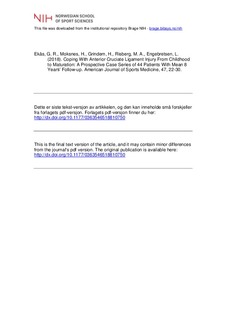Coping With Anterior Cruciate Ligament Injury From Childhood to Maturation: A Prospective Case Series of 44 Patients With Mean 8 Years’ Follow-up
Journal article, Peer reviewed
Accepted version
Permanent lenke
http://hdl.handle.net/11250/2595664Utgivelsesdato
2018Metadata
Vis full innførselSamlinger
- Artikler / Articles [2096]
- Publikasjoner fra Cristin [1084]
Sammendrag
Background: There is no consensus regarding the best treatment approach for skeletally immature children with anterior cruciate ligament (ACL) injuries. High-quality studies with long-term follow-up are lacking, and evidence to support decision making is limited. Purpose: To evaluate functional and patient-reported outcome, surgical history, and complications among young adults who sustained an ACL injury before the age of 13 years and were treated with active rehabilitation and the option of delayed ACL reconstruction if needed. Study Design: Case series; Level of evidence, 4. Methods: Forty-six children aged <13 years with a total intrasubstance ACL injury were included. None of these patients had additional injuries that warranted early surgery. At final follow-up at a mean 8 years after the time of injury, 44 patients remained in the study. The same test battery was conducted at baseline, 1 and 2 years, and final follow-up at approximately 18 years of age. The test battery included functional tests (hop tests and isokinetic muscle strength tests of quadriceps and hamstrings), patient-reported outcome measures (including the Knee injury and Osteoarthritis Outcome Score and the International Knee Documentation Committee Subjective Knee Form), and clinical examination. Medical records were reviewed to assess surgical history and complications. Results: At a mean 8 years of follow-up, 24 patients (55%) had undergone ACL reconstruction, and 16 (36%) had undergone meniscal surgery. Quadriceps muscle strength symmetry was >90% for 30 patients (68%). Mean leg symmetry indexes for hop and strength tests were consistently >90%, except for the single-hop test and hamstrings muscle strength for ACL-reconstructed knees. Mean ± SD International Knee Documentation Committee scores were 86.3 ± 13.7 for the ACL-reconstructed knees and 90.6 ± 11.8 for the nonreconstructed knees. At final follow-up, forty patients (91%) remained active in sports, but 29 (66%) restricted their activity level to nonpivoting sports. Conclusion: Active rehabilitation may have a role in treatment of children with ACL injury. Approximately 50% of children may cope well, even to adulthood, without a surgical intervention. The other half may develop instability that warrants ACL reconstruction, and one-third may require meniscal surgery.
Beskrivelse
I Brage finner du siste tekst-versjon av artikkelen, og den kan inneholde ubetydelige forskjeller fra forlagets pdf-versjon. Forlagets pdf-versjon finner du på sagepub.com: http://dx.doi.org/10.1177/0363546518810750 / In Brage you'll find the final text version of the article, and it may contain insignificant differences from the journal's pdf version. The definitive version is available at sagepub.com: http://dx.doi.org/10.1177/0363546518810750
